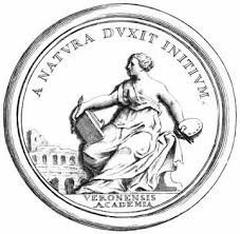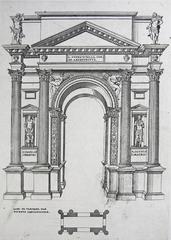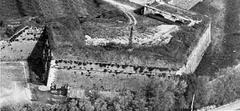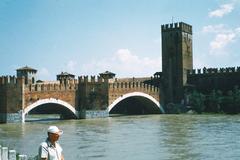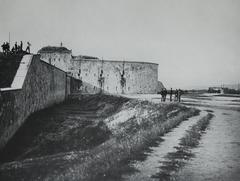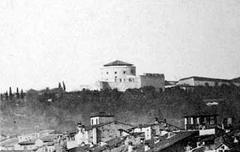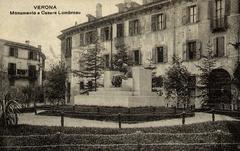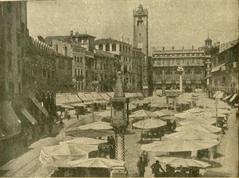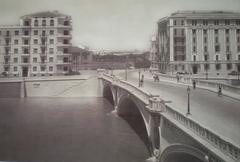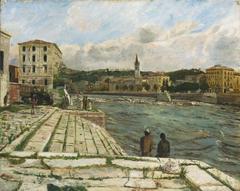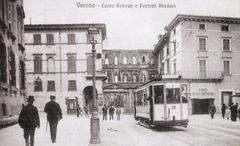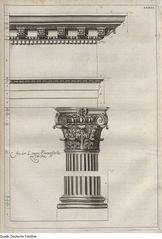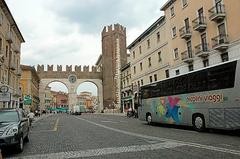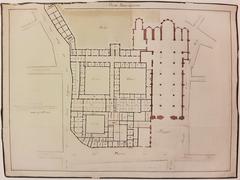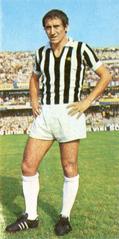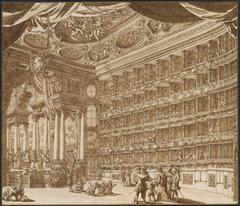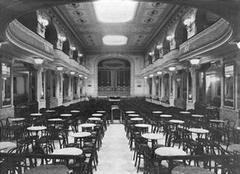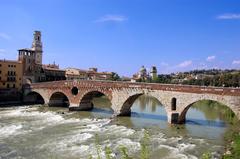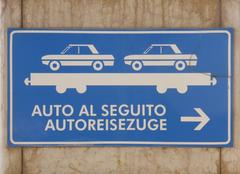Castelvecchio Museum Verona: Visiting Hours, Tickets, and Complete Visitor Guide
Date: 14/06/2025
Introduction: History and Cultural Significance
Rising above the Adige River in Verona, the Castelvecchio Museum is a cornerstone of the city’s cultural and architectural heritage. Originally erected in the mid-14th century by Cangrande II della Scala as a formidable medieval fortress, Castelvecchio (“Old Castle”) was designed to defend both the ruling dynasty and the city during an era of political turbulence. Over centuries, the castle evolved under Venetian, Napoleonic, and Austrian rule, each phase leaving distinctive imprints on its structure and purpose (Wikipedia; veronissima.com).
Today, Castelvecchio stands not only as a symbol of Verona’s resilience but also as a vibrant museum. Its vast collections of sculpture, painting, arms, ceramics, and decorative arts trace northern Italy’s artistic legacy from antiquity through the Renaissance. The 20th-century restoration by architect Carlo Scarpa transformed the castle’s interiors, fusing medieval architecture with modern museography and setting global standards for historic preservation (archiobjects.org; Atlante Architettura Contemporanea).
With its 29 exhibition halls, panoramic towers, and iconic Ponte Scaligero, Castelvecchio offers a compelling experience for history enthusiasts, art lovers, and travelers eager to explore the heart of Verona. This comprehensive guide details Castelvecchio Museum visiting hours, ticketing, highlights, accessibility, and practical tips, ensuring you make the most of your visit.
Table of Contents
- Introduction: History and Cultural Significance
- Medieval Origins and Strategic Role
- Transformations Through the Centuries
- Early 20th-Century Restorations
- Carlo Scarpa’s Restoration: Vision and Impact
- Museum Collections: Highlights and Must-Sees
- Visiting Castelvecchio: Hours, Tickets & Visitor Info
- Accessibility and Facilities
- Guided Tours, Events & Photography
- Nearby Attractions and Travel Tips
- Frequently Asked Questions (FAQ)
- Conclusion and Final Tips
- References
Medieval Origins and Strategic Role
Built between 1354 and 1376 for Cangrande II della Scala, Castelvecchio was conceived as both a military stronghold and a dynastic symbol. Its strategic riverside location enabled surveillance of the city and provided an escape route via the fortified Ponte Scaligero (Wikipedia). The castle’s massive walls, seven towers, and deep moat exemplify the defensive priorities of the Scaliger dynasty during Verona’s medieval peak.
Transformations Through the Centuries
Venetian and Napoleonic Eras
After the Scaliger dynasty’s fall in 1387, Castelvecchio was adapted by successive rulers. Under Venetian control (1405–1797), the castle became a military barracks and arsenal, with modifications that preserved its medieval character. The Napoleonic period brought further militarization, including the addition of new fortifications, lowered towers, and the removal of battlements, giving the fortress a stark, utilitarian appearance (veronissima.com).
Austrian Occupation and 19th-Century Modifications
Post-1815, Austrian rule reinforced the castle’s role as a garrison, further altering its appearance—towers were truncated, and medieval features were removed or obscured. By the late 19th century, Castelvecchio was a functional military structure, stripped of much of its original grandeur (veronissima.com).
Early 20th-Century Restorations
In the 1920s–30s, director Antonio Avena led a restoration campaign to revive the castle’s medieval splendor. Relying on historic paintings and imagination, Avena reconstructed towers and battlements—sometimes inventing features without historical basis—and integrated salvaged Gothic-Venetian decorations. While atmospheric, these interventions blended fact and fantasy, later drawing criticism for prioritizing spectacle over accuracy (veronissima.com).
Carlo Scarpa’s Restoration: Vision and Impact
A New Philosophy of Restoration
From 1956–1975, architect Carlo Scarpa undertook a pioneering restoration, setting international benchmarks for the adaptive reuse of historic sites (archiobjects.org). Scarpa refused to “recreate” a medieval castle; instead, he highlighted the building’s layered history by juxtaposing old and new, using “cuts and caesuras” to reveal the structure’s evolution (Atlante Architettura Contemporanea).
Architectural Innovations
Scarpa’s meticulous design includes custom fixtures, floating staircases, and innovative display cases that both protect and showcase artworks. Contemporary materials—steel, concrete, glass—are used thoughtfully, always distinguishable from original masonry. The interplay of light, space, and historic textures creates a museum environment that is itself a work of art (archiobjects.org).
Impact and Legacy
Scarpa’s restoration is widely studied and admired globally, influencing generations of architects and curators. The museum’s layout encourages visitors to engage with both the art and architecture, revealing the passage of time and the dialogue between eras (veronissima.com).
Museum Collections: Highlights and Must-Sees
Sculpture: Romanesque and Gothic Masterpieces
The ground floor features Romanesque and Gothic sculptures from Verona’s churches (10th–14th centuries), including capitals, reliefs, and lavish funerary monuments (Italy Guides).
Paintings: Medieval to Baroque
- Madonna of the Quail by Pisanello: A late Gothic masterpiece (Italy Guides).
- Madonna of the Rose Garden by Stefano da Verona.
- Works by Jacopo and Giovanni Bellini, Liberale da Verona, and Tintoretto.
- Deposition by Paolo Veronese: An example of Baroque religious art.
The Equestrian Statue of Cangrande I della Scala
A highlight is the equestrian statue of Cangrande I, originally from the Scaliger Tombs, now displayed as a symbol of the city’s medieval legacy (History Hit).
Arms and Armor
The armory displays swords, helmets, shields, and polearms that reflect the castle’s military history, including the famous sword of Cangrande (Italy Guides).
Decorative Arts
Collections include jewelry, ceramics, majolica, goldsmith works, and illuminated manuscripts, illustrating Verona’s refined craftsmanship (Italy Museum).
Roman Antiquities
Roman mosaics, frescoes, and fragments connect the museum to Verona’s ancient past (History Tools).
Temporary Exhibitions
The Boggian Room in the courtyard hosts rotating exhibitions on thematic or monographic subjects (Italy Guides).
Visiting Castelvecchio: Hours, Tickets & Visitor Info
Visiting Hours
- Tuesday to Sunday: 8:30 AM – 7:30 PM (last admission 6:45 PM)
- Monday: Closed
- Hours may vary on holidays—always check the official Castelvecchio Museum website for updates.
Ticket Prices
- Full price: €10
- Reduced: €7 (EU citizens 18–25)
- Free: Under 18, over 65, disabled visitors and companions, teachers, Verona Card holders
- Tickets are available online or on site; advance booking is recommended in high season (Italy Museum).
Accessibility and Facilities
- Wheelchair Access: Ramps and elevators make most areas accessible. Some upper levels and towers may be restricted due to historic architecture. Contact the museum in advance for specific needs.
- Facilities: Restrooms, a gift shop, and multilingual information panels are available. Dining options are nearby.
Guided Tours, Events & Photography
- Guided Tours: Offered in multiple languages; advance booking recommended.
- Special Events: Regular temporary exhibitions and workshops; check the website for current events.
- Photography: Permitted without flash or tripods. The Ponte Scaligero and battlements offer exceptional photo points.
Nearby Attractions and Travel Tips
Castelvecchio is centrally located, easily combined with:
- Arena di Verona
- Piazza delle Erbe
- Juliet’s House
- Basilica di San Zeno The Verona Card combines museum entry with public transit and other attractions (Verona Tourism Official Site).
Getting There: The museum is at Corso Castelvecchio 2, within walking distance of major landmarks. Bus and tram stops are nearby; parking garages are available within a short walk.
Tips:
- Plan 1–2 hours for your visit.
- Wear comfortable shoes for cobblestones and stairs.
- Use the Verona Card to save on multiple entries.
Frequently Asked Questions (FAQ)
What are Castelvecchio Museum’s opening hours?
Tuesday to Sunday, 8:30 AM–7:30 PM (last entry 6:45 PM). Closed Mondays.
How much are tickets?
Full price is €10; reduced and free tickets are available for eligible visitors.
Is the museum wheelchair accessible?
Yes, most areas are accessible; some upper levels may be difficult due to historic features.
Are guided tours offered?
Yes, in multiple languages. Book in advance for best availability.
Can I take photos?
Photography is allowed without flash or tripods.
Where can I buy tickets?
At the museum or online via the official website.
Visual Highlights
- Exterior: “Castelvecchio Museum and Scaliger Bridge in Verona”
- Masterpieces: “Madonna of the Quail by Pisanello at Castelvecchio”
- Iconic Sculpture: “Equestrian statue of Cangrande I della Scala”
- Interior Design: “Carlo Scarpa’s restoration details at Castelvecchio”
Conclusion and Final Tips
Castelvecchio Museum is a must-see for anyone exploring Verona’s rich heritage. Its fusion of medieval fortifications, innovative restoration, and world-class art collections offers a multifaceted experience—whether you’re a history buff, architecture enthusiast, or art lover. Check current visiting hours and ticket options on the official Castelvecchio Museum website, and consider using the Verona Card. Pair your visit with other city highlights for a rewarding day in Verona.
For audio guides, up-to-date event notifications, and more tips, download the Audiala app. Share your experience on social media with #VisitVerona and stay connected for the latest updates.
